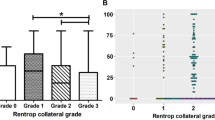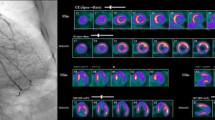Abstract
To assess the physiologic significance of well-developed collaterals, 34 patients, with isolated left anterior descending artery disease (LAD) and without overt prior myocardial infarction, underwent cardiac catheterization and exercise thallium-201 emission computed tomography. The patients were divided into 3 groups; 11 patients with 90% stenosis of the proximal LAD and without collaterals (group 1), 11 with 99% stenosis of the proximal LAD, and without collaterals (group 2) and 12 with a total occlusion of the proximal LAD which was completely filled by well-developed collaterals (group 3). On left ventriculography, shortening fractions of the anterior wall were significantly reduced in group 2 as compared to group 1 and 3 (group 1 vs group 2: p< 0.01, group 2 vs group 3: p< 0.05), which reflected the lower ejection fraction of group 2 (p< 0.01 and p< 0.05, respectively). The perfusion defects of the anterior wall on both the initial and the delayed images were severer in groups 2 and 3 than in group 1 (group 1 vs group 2 and group 1 vs group 3 on the initial image: p< 0.01, for both, group 1 vs group 2 and group 1 vs group 3 on the delayed image: p< 0.05, for both). However, recovery of the perfusion defects from the initial image to the delayed image was better in group 3 than in groups 1 and 2 (group 1 vs group 2 and group 1 vs group 3: p< 0.05, for both). Therefore, coronary blood flow through well-developed collaterals was considered to be comparable to the flow through a diseased vessel with 90% stenosis at rest. During maximal exercise, blood flow through well-developed collaterals was considered to be comparable to the flow through a diseased vessel with 99% stenosis, although the blood flow through well-developed collaterals was considered to be better than that through 99% stenosis during the recovery period. These findings suggest that patients with well-developed collaterals must be treated like those with severe stenosis.
Similar content being viewed by others
References
Eng C, Patterson RE, Horowitz SF, et al: Coronary collateral function during exercise.Circulation 66: 209–316, 1982
Juilliere Y, Danchin N, Grentzinger A, et al: Role of previous angina pectoris and collateral flow to preserve left ventricular function in the presence or absence of myocardial infarction in isolated total occlusion of the left anterior descending coronary artery.Am J Cardiol 65: 277–281, 1990
Levin DC: Pathways and functional significance of coronary collateral circulation.Circulation 83: 831–837, 1974
Hanby RI, Aintablian A, Schwartz A: Reappraisal of the functional significance of the coronary collateral circulation.Am J Cardiol 38: 305–309, 1976
Kolibash AJ, Bush CA, Wepsic RA, Schroeder DP, Tetalman MR, Lewis RP: Coronary collateral vessels: Spectrum of physiologic capabilities with respect to providing rest and stress myocardial perfusion, maintenance of left ventricular function and protection against infarction.Am J Cardiol 50: 230–238, 1982
Rigo P, Becker LC, Griffith LSC, et al: Influence of coronary collateral vessels on the results of thallium-201 myocardial stress imaging.Am J Cardiol 44: 452–458, 1979
Fujita M, Sasayama S, Asanoi H, Nakajima H, Sakai O, Ohno A: Improvement of treadmill capacity and collateral circulation as a result of exercise with heparin pretreatment in patients with effort angina.Circulation 77: 1022–1029, 1988
Lambert PR, Hess DS, Bache RJ: Effect of exercise on perfusion of collateral-dependent myocardium in dogs with chronic coronary artery occlusion.J Clin Invest 59: 1–8, 1977
Freedman SB, Dunn RF, Bernstein L, Morris J, Kelly DT: Influence of coronary collateral blood flow on the development of exertional ischemia and Q wave infarction in patients with severe single-vessel disease.Circulation 71: 681–686, 1985
Gregg DE, Patterson RE: Functional importance of the coronary collaterals.N Eng J Med 303: 1404–1406, 1980
Austen WG, Edwards JE, Frye RL, et al: A reporting system on patients evaluated for coronary artery disease.Circulation 51: 5–40, 1975
Sheehan FH, Bolson EL, Dodge HT, Mathey DG, Schofer J, Woo HW: Advantages and applications of the centerline method for characterizing regional ventricular function.Circulation 74: 293–305, 1986
Kennedy JW, Trenholme SE, Kasser IS: Left ventricular volume and mass from single plane angiogram: a comparison of anteroposterior and right anterior oblique methods.Am Heart J 80: 343–352, 1970
Kurata C, Sakata K, Taguchi T, Kobayashi A, Yamazaki N: Exercise-induced silent myocardial ischemia by thallium-201 emission computed tomography.Am Heart J 119: 557–567, 1990
Fujita M, Sasayama S, Araie E, Ohno A, Yamanishi K, Hirai T: Significance of pre-infarction angina for occurrence of post-infarction angina.Eur Heart J 9: 159–164, 1988
Chilian WM, Mass HJ, Williams SE, Layne SM, Amith EE, Scheel KW: Microvascular occlusions promote coronary collateral growth.Am J Physiol 258:H1103-H1111, 1990
Rentrop KP, Feit F, Sherman W, Thornton JC: Serial angiographic assessment of coronary artery obstruction and collateral flow in acute myocardial infarction: Report from the second Mount Sinai-New York University: Reperfusion trial.Circulation 80: 1166–1175, 1989
Cuttino JT, Bartrum RJ, Hollenberg NK, et al collateral vessel formation: Isolation of a transferable factor promoting a vascular response.Basic Res Cardiol 70: 568–573, 1975
Barath P, Jakbowski AT, Cao J, et al: Feasibility of heart neovascularization by intracoronary fibroblast growth factor.Circulation 78 (suppl II): II-57, 1988
Martin CM, McConahay DR: Maximal treadmill exercise electrocardiography: Correlation with coronary arteriography and cardiac hemodynamics.Circulation 46: 956–962, 1972
Fuster V, Frye RL, Kennedy M, Connolly DC, Mankin HT: The role of collateral circulation in the various coronary syndromes.Circulation 59: 1137–1144, 1979
Goldberg HL, Goldstein J, Borer JS, Moses JW, Collins MB: Functional importance of coronary collateral vessels.Am J Cardiol 53: 694–699, 1984
Berger B, Watson DD, Taylor GJ, Burwell LR, Martin RP, Beller GA: Effect of coronary collateral circulation on regional myocardial perfusion assessed with quantitative thallium-201 scintigraphy.Am J Cardiol 40: 365–370, 1980
Cooper R, Puri S, Francis CK, Spencer RP: Role of coronary artery disease and collateral circulation in redistribution of thallium-201.Clin Nucl Med 5: 292–298 1980
Author information
Authors and Affiliations
Rights and permissions
About this article
Cite this article
Sakata, K., Yoshida, H., Ono, N. et al. Physiologic capacity of well-developed collaterals in patients with isolated left anterior descending artery disease. Ann Nucl Med 6, 13–20 (1992). https://doi.org/10.1007/BF03164637
Received:
Accepted:
Issue Date:
DOI: https://doi.org/10.1007/BF03164637




